| Soldier
Khan
By Mike Bennighof, Ph.D.
March 2016
On the very right-hand fringe of the Soldier Kings European map sits one of the game's most powerful
minor countries, Crimea. As one of those countries
that no longer exists, its presence is a mystery
to some, but for centuries the Crimean Tatars
struck such fear in Eastern Europe that mothers
did not dare tempt fate by threatening misbehaving
children with them.
On the plains north of the Black Sea, descendants
of the Mongol Golden Horde remained in place
long after the death of the Great Khan ended
the invasion of Europe. Nogai, grandson of
Genghis Khan and unofficial leader of the
Golden Horde, had established a semi-independent
dynasty there by the year 1300. Even after
the Golden Horde re-asserted its authority,
the Crimean beys retained substantial autonomy,
and were made rich by trade with the Genoese
outposts on the southeast coast of the Crimean
peninsula — the leading port, Caffa,
is best known as the source of the Black Death
that devastated Europe. Islam arrived in the
13th century, and by the time of Nogai the
Sunni branch had become the dominant religion.
Although a literate people from the inception
of Islam, the Tatars have never translated
the Qu'ran into their own language.
That all changed in the 1430s when the Crimean
Tatars, as they were now known, invited Haji
Giray to become their khan and lead their
struggle for independence from the Golden
Horde. Haji was a descendent of Genghis Khan
(a prerequisite for rulership in the Mongol
sphere; even Ivan the Terrible made the claim)
and a politically astute leader. He forged
alliances with both of the region's rising
powers — Muscovy and the Ottomans —
and leveraged these against the rapidly decaying
Golden Horde. By 1441 he was coining his own
money and Crimean independence was secure.
 |
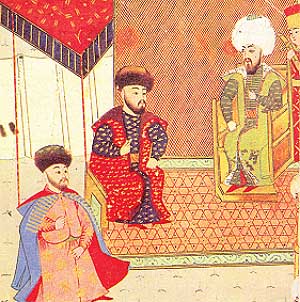
Haji Giray sits at the feet of his "brother,"
Mehmed the Conqueror. |
 |
|
After Haji's death, civil war broke out among
his relations, with his son Menli and another
relative, Nurdevlet, making the strongest
claims. Each was alternatively supported by
the Genoese, who still controlled five small
ports in Crimea and hoped to keep the Tatars
weak and divided. But in 1475 an Ottoman fleet
arrived to put an end to these distant Italian
colonies — Sultan Mehmed the Conqueror
had not forgotten Genoa's contribution to
the defense of Constantinople against his
armies. The Ottomans took the ports one by
one, and for good measure they besieged the
tiny principality of Theodoros. This Greek-ruled
offshoot of the Byzantine Empire occupied
the areas around the modern Bay of Sevastopol
and the valley just to the east. Its people,
known as the Crimean Goths, were the last
remnants of the great Gothic kingdoms of late
Antiquity and spoke a Germanic language.
The Turks found Menli chained to a dungeon
wall in Caffa, the center of the Genoese colonies.
The Ottomans returned him to power by force
and drove off Nurdevlet, the favorite of the
Genoese. While the Ottoman campaign went on,
an army from the Golden Horde surged into
the peninsula to re-assert the Great Khan's
authority, only to be driven off by the Ottomans.
Ottoman chronicles are confused regarding
the exact sequence, but both Menli and Nurdevlet
appear to have been installed, deposed, imprisoned
and rehabilitated by the Ottomans several
times each before Menli was put on the throne
once and for all in 1478. Theodoros and the
formerly Genoese ports were kept by the Ottomans
as a sanjak, or province, ruled by an appointed
governor. But the rest of the peninsula, plus
the steppes between the Sea of Azov and the
River Dnepr, formed the independent khanate.
The khan was not appointed by the sultan,
who referred to him as "brother"
but did however hold the right of approval
over the installation of a new khan. The khan
issued money and Friday prayers were said
in his name — the marks of an independent
sovereign in the Islamic world.
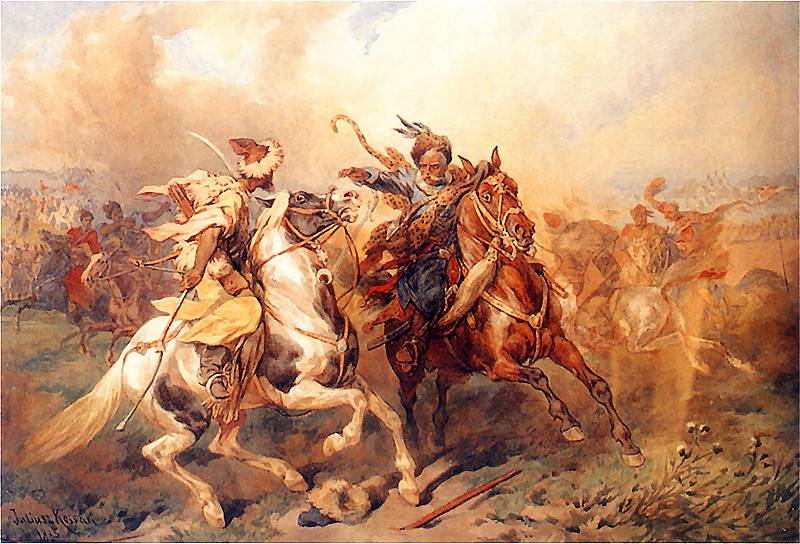
"Tatar's Dance," Juliusz Kossak.
Crimean Tatar (left) used his pony's
speed and a whip to hold off a Polish
"winged hussar." |
 |
| |
 |
Menli led a large contingent of Crimean cavalry
alongside Sultan Bayezid II in 1484, marking
the start of three centuries of a Turk-Tatar
military alliance and a less pleasant tradition.
The combined armies besieged the Moldavian
fortress of Akkerman on the Black Sea coast,
and its garrison surrendered after the Turks
assured its commanders that they had reached
an agreement with the prince of Moldavia for
the troops and civilian inhabitants to depart
peacefully. When the Moldavians were out from
behind the walls, Menli pointed out that as
an independent ruler he was not bound by any
such convention nor were his men. The Tatars
rode down the startled and now defenseless
garrison and slaughtered thousands, both soldiers
and civilians, and carried off thousands more
as slaves.
For the next 300 years, slave raiding would
be the foundation of the Crimean Khanate's
economy. Three million people passed through
the huge slave market at Caffa — over
10,000 people per year. Most were Ukrainians,
with large numbers of Poles and Russians as
well. Raiding parties, known as tchambuls,
roved northward into the Ukrainian steppe
in search of new victims even during peacetime,
seeking not only to find profit but to preserve
a wide uninhabited buffer zone between the
Khanate and its hostile Christian neighbors.
Calculations of war and peace often rested
on the number of slaves to be taken, current
prices, and market conditions.
Very few slaves remained in the Khanate
— almost all were exported across the
Black Sea to Constantinople. Roxelana, favorite
concubine of Sultan Suleiman the Magnificent,
passed through the Caffa market sometime in
the 1520's. Slave raids undertaken without
the Khan's permission were officially banned
but as the punishment consisted of a heftier
tax on any slaves taken, the ruler did not
remain angry long when his riders defied his
edicts — traders paid 10 percent on
slaves taken legally, 20 percent on those
taken without official sanction. Even unwary
Christian allies of the Khan could find themselves
in chains. The Tatars built impressive cities
with their profits; Bachisaray, their capital,
was one of the Islamic world's great cities,
noted for its Islamic schools and library.
 |
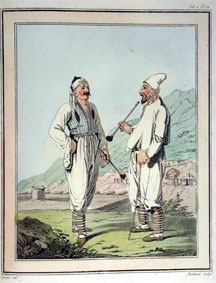
Two Crimean Tatars during peacetime,
enjoying a friendly pipe. |
 |
|
Tatar slave raiding led directly to Poland's
formation of Cossack bands, pledged to protect
the borderlands from these enemies. Yet often
the Cossacks found themselves having more
in common with the Tatars than with their
Christian overlords, and a quiet trade developed
where these protectors sold their peasant
charges to the enemy. Tatar cavalry also rode
to the aid of Cossack rebellions against their
Polish overlords.
The Khan possessed immense military potential.
Most of his people living on the steppe made
their living herding cattle. On the peninsula
itself, a strong leather industry developed
along with metallurgy and agriculture —
fruit, wine and tobacco. Non-Muslims appear
to have suffered little if any harassment,
though they were subject to special taxes
in exchange for their exemption from military
service. All Muslim men were expected to ride
at the Khan's command, and the Crimea regularly
put armies exceeding 100,000 hardened light
cavalry into the field.
These armies were organized similarly to the
old Mongol hordes, in units of 100, 1,000
and 10,000 riders. There were no other services;
the Tatars depended on the Turks to provide
engineers, artillery and infantry when necessary.
The men carried a curved sword, a bow and
a lance until the end of the khanate. Firearms
were often disdained for the more rapid fire
possible with arrows.
The high point of Crimean military exploits
came in 1571, when a Tatar force led by Khan
Divlet Giray torched Moscow. But already the
Ottoman-Crimean alliance was starting to chafe,
as Sultans demanded rather than requested
Tatar participation in their military campaigns
and the Khans pursued independent diplomacy
with Turkish enemies like Persia and Poland.
Meanwhile, Muscovy's power grew as the tsars
smashed the khanates of Kazan and Astrakhan
to the east.
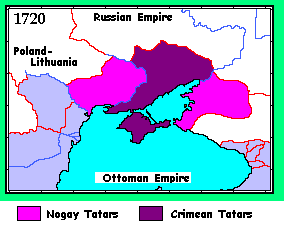
The Khanate in 1720, already in decline. |
 |
| |
 |
To keep the khans in line, the Ottomans usually
kept at least one pretender to the throne
at hand, and khans regularly gained and lost
the throne, some of them three and four times.
But during the 1640s, Islam III Giray managed
to separate Cossack loyalties from Poland,
and Turkish and Tatar forces advanced into
Ukraine with an eye toward expanding their
influence northward. But the Cossacks turned
to Moscow in 1654, and the Turkish defeat
in front of Vienna in 1683 changed everything.
Crimean armies now fought in the Balkans to
stem the Austrian advance while Polish and
Russian invasions also drove back the alliance's
borders.
While the front would eventually be stabilized, the Khanate
was on the defensive for the rest of its existence.
The Russians pressed steadily southward, and
in 1736 a Russian army briefly captured Bachisaray,
burning the Khan's palace, the Islamic school
and the massive library. The Russo-Turkish
War of 1768 to 1774 was disastrous for the
Khanate. After a successful large-scale raid,
the Tatars proved unable to stop a Russian
invasion of the Crimea while promised Ottoman
reinforcements failed to arrive. The Khan
fled to Constantinople, and the nobles left
behind intrigued with the Russians to cut
the Ottoman ties outright.
 |
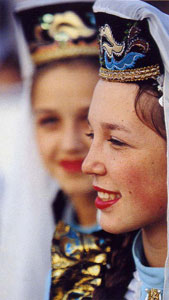
Crimean Tatars just outside Ankara. |
 |
|
The Treaty of Kuchuk-Kainarji in 1774 gave
the Khanate supposed independence but codified
Russian influence. Sahin Giray, the last of
the khans, tried to re-organize taxation to
fund a modern, Western-style military structure
but the nobles, previously exempt, followed
the example of countless other nations and
violently resisted. Catherine II used her
treaty rights as a pretext to interfere in
one of the incessant civil wars in 1783, annexing
the Khanate's lands and exiling Sahin, who
was eventually executed by the Turks. While
Catherine supported Islam in the belief it
could be used to make her subjects more pliable,
later rulers had a much less benevolent view.
The Tatars would be steadily repressed under
the tsars, until in 1944 Josef Stalin declared
them "potential traitors for all time"
and hundreds of thousands were massacred or
exiled to Siberia. Many fled to Turkey, where
a vibrant community remains.
In Soldier
Kings, the Crimea is a powerful minor
state with seven armies (as many as Spain),
though they are very weak. Its diplomatic
modifiers are such that it will almost always
ally only with Turkey. The depiction of the
Khanate's military strength is about right:
the Khan during the early part of the Seven
Years' War, Arslan Giray, felt a Russian attempt
to conquer his people inevitable and spent
his reign building the Khanate's defenses.
So tight were the Turkish-Tatar ties that
we put him in Turkish colors in the game;
while this is accurate — Arslan even
commanded Turkish armies suppressing rebels
in the Balkans — he should always start
in Crimea.
Send
the Tatars to war in Soldier Kings,
available now.
Mike Bennighof is president of Avalanche Press and holds a doctorate in history from Emory University. A Fulbright Scholar and award-winning journalist, he has published over 100 books, games and articles on historical subjects.
He lives in Birmingham, Alabama with his wife, three children and his dog, Leopold.
|
